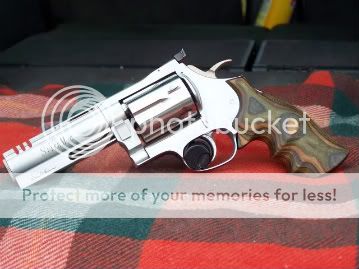We had a stuck case at the range recently. Here was the situation….
Guy shooting next to me was a reloader and caster….
First a squib load… had to help guy push the cast bullet out with my trusty brass rod with tape washers…. (yes I keep a brass rod of 12" and some masking tape) and a Stanley soft head hammer in the range bag.
Then the fellow reloads the cylinder of his revolver…. BLOOM! a real HOT load goes off.
Sounded like a double charge to me…. sure enough… the guy cannot get the case out of his .38 Special revolver's cylinder…. We tap it out with some KROIL lube.. and the brass rod again….
Low and behold the primer is TOTALLY flat and no primer indent from the firing pin, it has been leveled… sure signs of high pressure.
I inspect the cylinder for any cracks or other signs of distress and it is good.
So yes, a really HOT load can so over expand the cartridge brass that it is very hard to get out of the cylinder….
December 4, 2009
 Offline
OfflineAmmo is from a local indoor pistol range.I do mix up between .38 and .357 a little bit depending on the trip.Also the walls of the interior of the cylinder seem to be machined is this normal to a DW?The grooves go partialy up from the base of the cartrige end . Anyway thank you all so far.
Supporter

Moderators

Dans Club
February 22, 2009
 Offline
OfflineMore than likely, needs a good cleaning. However- could be a hot load, but sounds like you may be shooting 'standard' over the counter ammunition, so here's another theory:
It may be you have a long throat in one or more chambers (or if using reloads, the brass needs trimmed). What happens, in this example, is when you slide a case into the cylinder, the mouth of the case rides over the throat rim. This causes more tension on the bullet and results in higher internal pressure when fired. This higher pressure has the same affect as a 'hot' load.
The good news is- I don't think that's your problem. Try cleaning first.
Technically, the glass is always full; half liquid, half air....
Supporter

Moderators
January 24, 2009
 Offline
Offlinerwsem said:
Try cleaning first.
Absolutely. Use a .40 caliber bore brush with gun solvent to clean out any built-up carbon that may have built up in the cylinder.
I have never had a stuck cartridge problem with factory ammo in my DW's...but I have had a few of my reloads stick. That's how it is with newbie reloaders, I guess. I keep a wooden dowel with me when shooting my reloads.
That's how it is with newbie reloaders, I guess. I keep a wooden dowel with me when shooting my reloads.
July 25, 2009
 Offline
OfflineSomething to think of, too: NEVER shoot with any oil or grease in the chambers of the cylinder!!! Dry them well first. (Barrel too!) Never carry ammo loaded in oiled cylinders. If the layer of oil doesn't lock up in tiny (or even big) dents in the brass after firing, burned and partially burned powder, unburned powder flakes or balls, and other goop and gunk will get in the oil at each reload and you're just begging to stick a casing.
I've reloaded for over 40 years and I've deliberately loaded some gawdawful stuff in a DW 715 without a bit of trouble. Might take a stern rap on the ejector rod with the heel of my hand but they come out. Anything that stout I don't use again and back off or try another load. There is a point with Blue Dot under 158 gr JHPs where I suppose you could momentarily stretch the cylinder and stick the brass. I ain't been there yet! (Got there once with a very nice S&W 19-3 that ended up no worse for the experience and a micrometer proved no permanent changes.)
I do NOT advise EVER loading over the recommended maximum printed in a recognized, published reloading manual. In fact, check two or three of them. NEVER use the maximum in any load until you "sneak up on it" from the lower loads. Very seldom is a maximum load the most accurate and often not even the quickest. There should almost always be a different powder or a different bullet in the same weight that will get what you want if the first one doesn't. (I have one favorite 158 gr JHP load I have used for deer and three different brand bullets shoot to three decidedly different velocities over my chronograph, and with varying precision, all with the same brass, powder and primer.)
Do not exchange primer types without working up to them carefully. Also, use a loading block to hold your casings while reloading and working up warm loads. That allows you to look into the cases and see the powder level before you seat bullets. That tale about the "squib" followed by a "double" would have been caught that way. Once you have a load you can trust you can use a progressive loader with some confidence. I still check drop weights every ten rounds max. (Frankly, for high-end loads I never use a progressive loader - just an old manual C-press.)
Be careful with reloads guys - yours or anyone else's. In fact, I NEVER shoot anyone else's reloads in any of my guns, nor do I reload for other shooters. I will use some commercial reloads I've come to trust but I now have a single source for that.
1 Guest(s)

 Register
Register Log In
Log In Home
Home





 Happyness is a Hot DW and a pile of used brass!!! Rich
Happyness is a Hot DW and a pile of used brass!!! Rich

